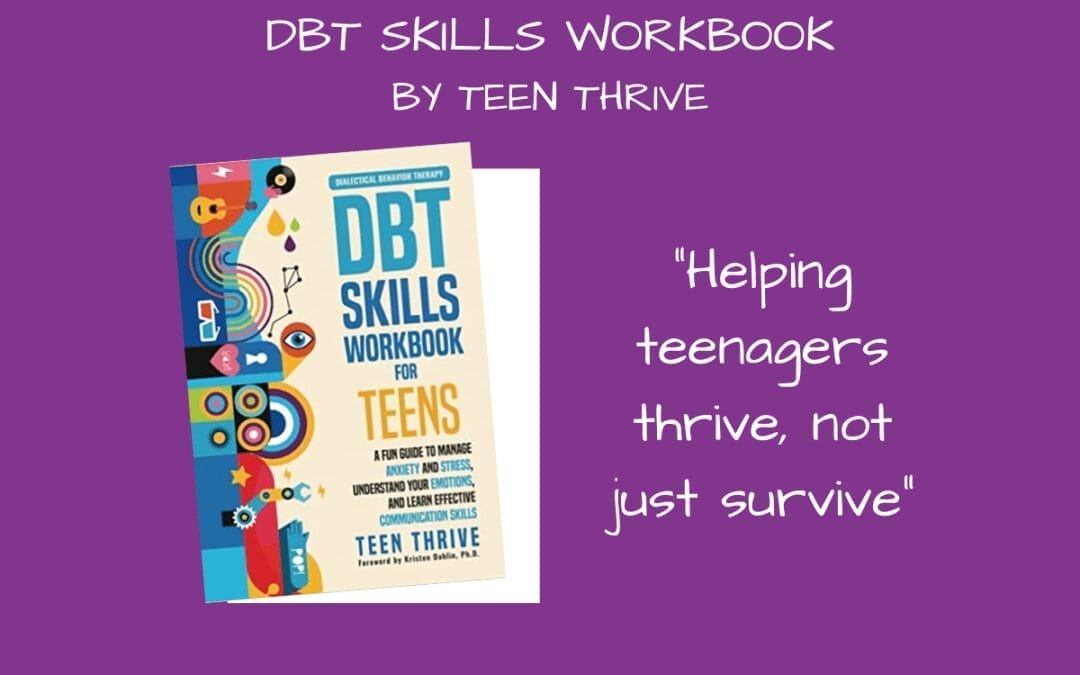Book Recommendation: ‘DBT skills workbook for teens: a fun guide to manage anxiety and stress, understand your emotions and learn effective communication skills’
By Teen Thrive: Foreword by Kristen Dahlin, DBT psychologist.
History of DBT
Dialectical behaviour therapy (DBT) was developed by Marsha Linehan in the 1980s. DBT has been successfully used to treat depression, bipolar disorder, eating disorders, drug misuse and PTSD. More recently, DBT has been used increasingly with children and teenagers struggling with anxiety.
DBT and teenagers
This DBT workbook has been designed specifically with teenagers in mind. Introducing the workbook Kristen Dahlin highlights that adolescence is the most challenging phase of life. As teenagers leave the comfort of childhood, some freefall into exam stress and peer/family pressure.
The aim of this publication is to prevent destructive habitual thoughts and behaviour, when faced with stressful situations. This is achieved through teaching the following core DBT strategies: emotional regulation, emotional regulation, distress tolerance and effective communication with others.
Teenage Quester
Teenagers are active participants in this workbook- like a boot camp for the psyche.
The workbook is divided into four sections: ‘quests’ that need completing in order. The layout is interactive, with plenty of space for answers to exercises. There are no right or wrong answers. The key is honesty and self-reflection:
- How do young people sabotage their thoughts?
- How do teenagers learn to exercise their ‘wise minds’?
In a fun, quest-inspired fashion, teenagers start to explore four sections.
- Mindfulness: accepting their ability to accept and be truly present in the current moment (mindfulness)
- Distress tolerance: strengthening tolerance of negative emotions, rather than trying to deny or escape from it.
- Emotional regulation: managing intense emotions and changing how we respond to them.
- Effective communication skills: honing assertiveness, maintaining self-respect and strengthening interpersonal relationships.
Each section is guided by imaginary teachers: Guru Dave, Sergeant Dawson, Retired Captain DB Turner and Captcha. Cool maps and objectives are given at the start, ending with certificates and invaluable life lessons. The quest morphs into an odyssey, with seemingly revered elders passing down ancient wisdom.
It isn’t a race. It’s about slowing-down time. Remember as a child when you spent hours drawing fantastical deep space voyages or enchanted forests? This book wants to take you back to being fully present in the moment.
Real-world application
The best learning comes through having fun. The hip graphics distinguishes this workbook from yet another book on mindfulness. The activities are fun yet sophisticated, game-ified yet thought-provoking. It doesn’t feel patronising, treating the teenager instead like an apprentice, eager to improve on emotional resilience.
Adolescence is a crucial period for developing and maintaining social and emotional habits for mental-well being. DBT techniques can help teenagers become aware of damaging, sabotaging thoughts in school or in relationships :
Seeing the bigger picture allows teenagers to not fall into the trap of seeing perception as reality, maintaining healthy emotional responses to disappointments or setbacks.
One of the keys to healthy friendships is effective communication. Using the motif of a sliding pressure modulation, teenagers learn about the subtleties of assertiveness:
Assessing the urgency of situations, balanced with the vulnerability allows for informed, mature decision-making.
Dialectics for life
This is an excellent workbook, offering clear activities on DBT strategies for teenagers.
At its core, DBT offers a therapeutic solution to life’s conundrums: dialectics. The two examples above show that teenagers can hold two oppositional viewpoints simultaneously: urgent (self) need and compassion for others’ vulnerability. Through reframing filtering, teenagers can also avoid black-or-white thinking fixations. The workbook offers lifelong emotional resilience training, helping teenagers thrive, not just survive.
It is however not a substitute for in-person therapy or a suicide preventation programme. If teenagers are already accessing therapy, it would be prudent for them to ask their therapist if this workbook is suitable for them to use alongside the therapy.
This workbook is an excellent guide to helping teenagers find the balance between accepting themselves and modulating what they don’t like about themselves and interactions with others.
Accessing Services
At Purple House Clinics, there are many expert Clinicians to help with a range of presentations from depression, anxiety, OCD, postnatal depression, post-traumatic stress disorder, childhood trauma, and personality disorder in a safe, therapeutic setting. For more information, please visit our website. https://www.purplehouseclinic.co.uk/


